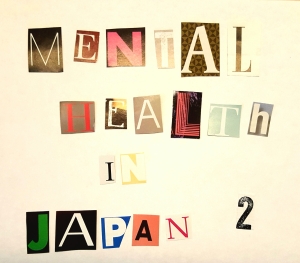 As promised, excerpts of my master’s dissertation will be published on Nippaku in an adapted version. This post will give an outline of the problem concerning mental health stigma. First, I will discuss the causes and consequences of stigmatization against people with a mental disorder in general and then focus on the specific situation in Japan. Interested in more mental health posts? Check out Iwakura: the Japanese Gheel (Mental Health in Japan Series no. 1) or The Medical Treatment and Supervision Act (2005): Forensic Mental Health in Japan Today – part 1 and part 2.
As promised, excerpts of my master’s dissertation will be published on Nippaku in an adapted version. This post will give an outline of the problem concerning mental health stigma. First, I will discuss the causes and consequences of stigmatization against people with a mental disorder in general and then focus on the specific situation in Japan. Interested in more mental health posts? Check out Iwakura: the Japanese Gheel (Mental Health in Japan Series no. 1) or The Medical Treatment and Supervision Act (2005): Forensic Mental Health in Japan Today – part 1 and part 2.1. Stigmatization of people with a mental disorder worldwide
 From various studies, we can conclude that stigma against individuals with a mental disorder is a real and serious problem worldwide[1]. First of all, people with a mental disorder often experience discrimination in housing, education and employment[2]. Not only does stigma influences the negative attitude of others who are otherwise unrelated to the health care industry, it has been proven that mental healthcare workers as well take a stigmatizing stance towards their patients[3]. Moreover, high-quality primary care and non-pharmacological care is often not sufficiently provided, which contributes to a pervasive experience of stigma. Apart from its social consequences, stigma also affects the patient on a personal level. Causing a loss of confidence and a further worsening of the emotional state, stigma has been called “the second illness”, because its effects are sometimes as harmful as the disorder itself[4]. Another critical problem is that stigmatization interferes at every stage of the process towards recovery, i.e. during diagnosis, treatment and rehabilitation[5]. Due to social stigma, mental health patients are much less likely to seek psychological help immediately, agree to treatment or return to society after having spent time at a mental institution. This self-stigmatizing attitude (the internalized type of stigma towards oneself[6]) forms a real barrier to optimal recovery, and is one of the main challenges in the field of mental health care today.
From various studies, we can conclude that stigma against individuals with a mental disorder is a real and serious problem worldwide[1]. First of all, people with a mental disorder often experience discrimination in housing, education and employment[2]. Not only does stigma influences the negative attitude of others who are otherwise unrelated to the health care industry, it has been proven that mental healthcare workers as well take a stigmatizing stance towards their patients[3]. Moreover, high-quality primary care and non-pharmacological care is often not sufficiently provided, which contributes to a pervasive experience of stigma. Apart from its social consequences, stigma also affects the patient on a personal level. Causing a loss of confidence and a further worsening of the emotional state, stigma has been called “the second illness”, because its effects are sometimes as harmful as the disorder itself[4]. Another critical problem is that stigmatization interferes at every stage of the process towards recovery, i.e. during diagnosis, treatment and rehabilitation[5]. Due to social stigma, mental health patients are much less likely to seek psychological help immediately, agree to treatment or return to society after having spent time at a mental institution. This self-stigmatizing attitude (the internalized type of stigma towards oneself[6]) forms a real barrier to optimal recovery, and is one of the main challenges in the field of mental health care today.
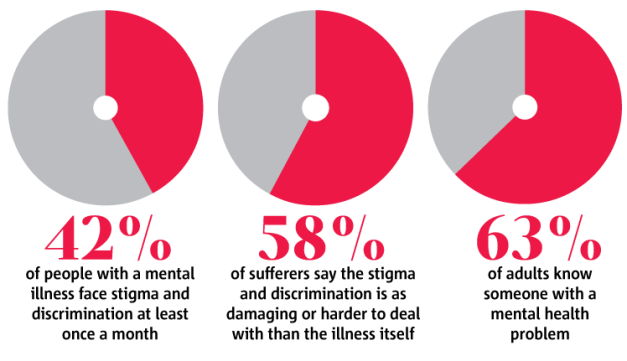
Mental health stigma in Britain – https://goo.gl/bYqWw0
Stigma is visible in various types of negative attitudes and prejudices. Moreover, the mentally disordered have been stigmatized throughout history. Contrary to people diagnosed with a physical illness, those with a disease of the mind are often regarded as irresponsible, weak and blameworthy, as if they hold responsibility for their own illness[7]. This stigmatizing attitude is reflected in the fact that not even 60 percent of surveyed states by the WHO had a dedicated mental health policy in 2011[8], and only 68 percent provided a mental health plan or legislation in 2014[9]. Additionally, stigma against people with a mental disorder is often promoted by false information in the media and entertainment industry. Not uncommonly, mentally disordered offenders are sensationally reported in the news, and by emphasizing the mental state of the offender, individuals with a mental disorder in general are labeled as inherently dangerous[10]. Stigma takes further concrete shape in derogatory terms and expressions based on such a discriminating attitude like “psycho”, “freak” or “nuts”[11] [12].
Another prevalent prejudice is that “mental health problems are untreatable”. According to a study by Lebowitz and Ahn, who had participants read vignettes emphasizing the treatability of mental disorders, stigma can be reduced by providing correct information on mental disorders[13]. Jorm et al. point out that the increase of public knowledge about depression leads to more recognition of the mental disorder, and in particular stimulates positive beliefs about treatment and the benefits of help-seeking[14]. In other words, it has been demonstrated that in order to deal with stigma, it is necessary to tackle the root problem, ignorance, first, which resulted in a sharp increase of campaigns focusing on “mental health literacy[15]” in the last two decades. For example, Crisp et al. compared the attitudes toward people with different mental disorders before and five year after the Changing Minds campaign in Great Britain. One of the improvements they reported was a reduction in the percentage of stigmatizing opinions[16]. On the other hand, mental health literacy campaigns should be continued on a long-term basis in order to achieve a sustained change[17]. There is, however, the possibility that negative attitudes do no change for the better, even if the public mental health literacy clearly increases[18].
2. The situation in Japan
Ando et al. reviewed nineteen surveys related to mental health stigma in Japan. They reached the conclusion that Japanese people in general have the tendency to regard mental disorders as untreatable diseases, caused by weakness of personality rather than by biological factors[1]. Other studies show that the stigmatization of mental patients in Japan is stronger than in Taiwan[2], Australia[3], Bali[4], but not as strong as in China[5]. Research on stigmatization of schizophrenia shows that the Japanese respondents heavily emphasize the “dangerousness” and “abnormality” of patients, a far more negative attitude than the British respondents[6]. Additionally, these kind of prejudices are not limited to a specific age or environment, as they have been found prevalent among young Japanese people[7] and the rural Japanese population[8] in contrast to other nationalities. We can conclude from the study results described here, that, in general, the tendency to stigmatize people with a mental disorder is relatively strong in Japan.

Example of a Japanese mental health stigma campaign.
One Japanese study demonstrates the close relationship between correct knowledge or information and social distance from individuals with a mental health problem among young people, in the sense that correctly informed youngsters took a less negative attitude towards the mentally disordered[9]. For that reason, mental health campaigns in Japan as well have been designed to deepen the understanding of the general public, and an increase can be noticed in television soaps and programs featuring people with a mental disorder without stereotyping them[10]. A further indication of efforts to reduce stigma is the decision in 2002 to change the word for “schizophrenia” in Japanese from seishin bunretsu byō 精神分裂病(“mind-split-disease”) to tōgō shicchō shō 統合失調症 (“comprehensive imbalance disorder”), the former expressing a lack of personal autonomy and thus contributing to a stigmatizing attitude[11]. According to a survey on dementia conducted in 2004, older people in Japan hold a slightly more negative opinion compared to younger people. When the same survey was repeated in 2007, the researchers found a reduction in stigmatization by the older age group against people with dementia[12]. Nevertheless, the same survey found that dementia is still strongly regarded as an “untreatable” and “shameful” disorder by Japanese people.

Illustrating mental health stigma – https://goo.gl/LnWOX
What affects the Japanese attitude even more directly, is the widespread prejudice that “people with a mental disorders are a danger for society[13]”. According to the most recent data from the Ministry of Justice, “the ratio of offenders with a mental disorder is 1.5%, but looking per offense, the ratio for arson (17.4%) and manslaughter (12.8%) is high[14]”. Certainly, we cannot deny the fact that among offenders of serious crimes like arson and manslaughter, the ratio of offenders with a mental disorder is rather high. However, the total ratio of mentally disordered offenders is only 1.5%, which makes a general judgment like “inherently dangerous” far from applicable to all people with a mental disorder[15]. Furthermore, Link et al. state in another study that, although it is correct that mental patients are generally more prone to use violence, the excess risk of violence due to the factor of a mental disorder is rather modest in comparison with other factors[16]. As a result of the prejudice linking mental disorders to violence, people with a mental disorder often experience segregation and isolation. Based on this false assumption, mental health patients themselves and their families generally believe that in case of a mental disorder, it is better to be hospitalized for a long period than being rehabilitated into society. This preconception is clearly reflected in statistics showing that Japan has not only the most hospital beds in general, but also the most beds for psychiatric patients worldwide (fig. 1 and 2).
figure 1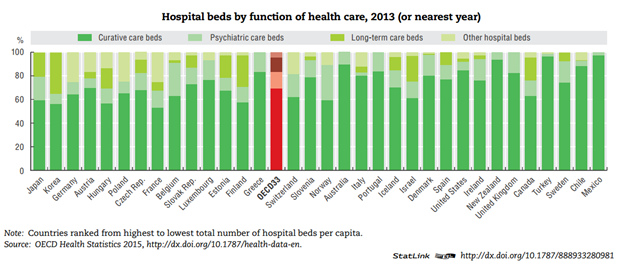 source: OECD. Health at a Glance 2015 OECD Indicators. Paris: OECD Publishing, 2015, p. 105.
source: OECD. Health at a Glance 2015 OECD Indicators. Paris: OECD Publishing, 2015, p. 105.
figure 2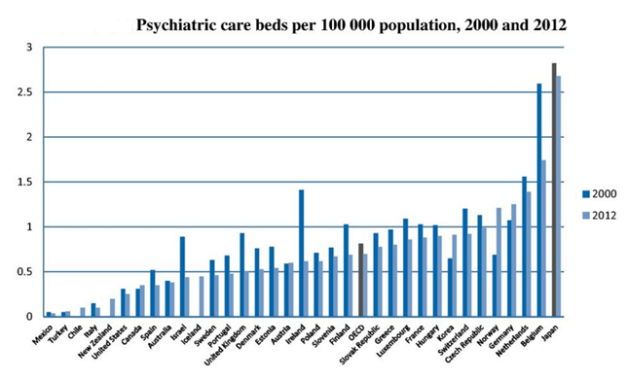 source: OECD. Reviews of Health Care Quality: Japan 2015 ; Raising Standards. OECD Reviews of Health Care Quality. Paris: OECD Publishing,2015, p.172.
source: OECD. Reviews of Health Care Quality: Japan 2015 ; Raising Standards. OECD Reviews of Health Care Quality. Paris: OECD Publishing,2015, p.172.
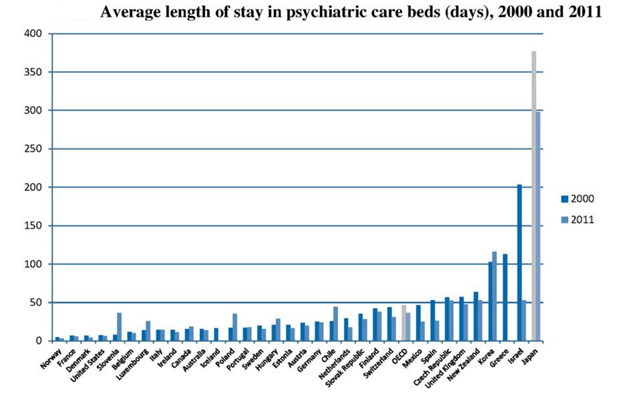 source: OECD. Reviews of Health Care Quality: Japan 2015, p. 172.
source: OECD. Reviews of Health Care Quality: Japan 2015, p. 172.Despite the fact that the number of psychiatric beds and the length of hospital stay for psychiatric patients has been decreasing, mental health care in Japan still faces a number of challenges in order to be able to make the step towards “deinstitutionalization” [18]. In Japan, however, “the community-based infrastructure remains underdeveloped with relatively low numbers of staff working in the community, and low numbers of supportive housing facilities, coupled with a strong emphasis on physical treatment rather than psychosocial treatments[19]”. It seems likely that the delay of an out-patient setting such as community-based care in Japan is partly rooted in the strong social stigma towards psychiatric patients because of the difficulties they face regarding reintegration.
Stigma is also believed to play a role in the high suicide rate in Japan (18,7 per 100,000 population in 2013[20]). Despite a decreasing rate from 2000 on, many Japanese struggling with mental health problems still fail to seek medical help due to the mental disorder taboo. Furthermore, the phenomenon “hikikomori”, adolescents and young adults withdrawing from society to extreme extents, has recently called attention to the mental wellbeing of the younger generation in Japan. A study revealed that in 2011, 1.2% of Japanese people aged 20 to 49 identified with hikikomori[21]. This phenomenon can be linked to (self-)stigmatization. Additionally, it has been revealed that many victims of the Great East Japan earthquake in 2011 suffer from mental health problems, which urges the rethinking of an accessible community-based mental health care system[22]. Considering the serious effects of social stigma, it is clear that this problem has to be dealt with in order to improve the challenging situation of individuals with a mental disorder.
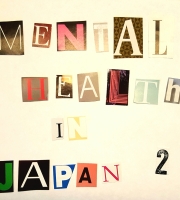

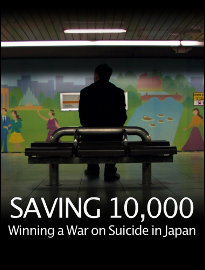
Pingback: The Perception of Mental Disorders in Ancient Japan | nippaku
Pingback: Old Stories of Madness | nippaku
Pingback: Mad Monks & Medieval Medicine | nippaku
Pingback: A History of Hansen’s Disease in Japan: the Isolation Policy as a Violation of Human Rights | nippaku
Pingback: Stop the Stigma – Mind Care
Pingback: Staging Madness: Nogaku vs. Kyogen | nippaku
Pingback: Fox Possession & Modern Medicine | nippaku
Pingback: Early Modern Mental Health Facilities in Japan | nippaku
Pingback: Mental Health and the Transition to a Modern Japan | nippaku
Pingback: How were people with a mental disorder perceived and stigmatized in Premodern Japan? A conclusion | nippaku